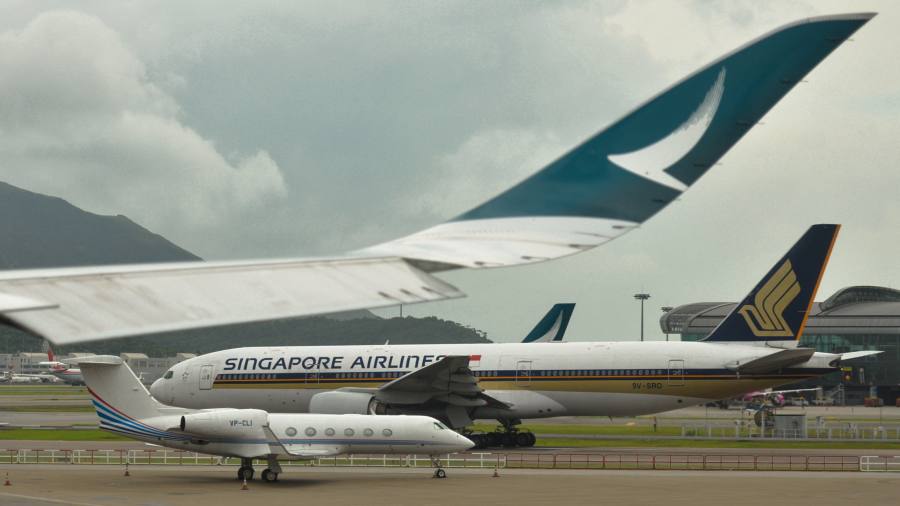
Just as Singapore Airlines was giving employees an eight-month salary bonus after record profits, Hong Kong was giving away more than 4,400 free tickets for regional rival Cathay Pacific as the city sought to encourage visitors to return.
Shares of Singapore Airlines have soared to their highest levels in more than three years after the national carrier made clear the strength of its post-pandemic recovery with an annual profit of S$2.16bn ($1.6bn) for the year ending in March.
In stark contrast, shares in Hong Kong-listed Cathay Pacific have dropped nearly 40 per cent from a high in April 2019. In March, the airline unveiled a HK$6.5bn ($830mn) loss for 2022 and shares have remained flat since.
Their financial divergence reflects the rise of Singapore, one of the first countries in Asia to reopen its borders after the pandemic, and the burnishing of its status as a business hub. Hong Kong, on the other hand, remained largely closed off to travel until late last year, losing its status as region’s busiest airport to Singapore in 2022. Its slow reopening has affected Cathay Pacific, which is also reeling from labour shortages.
“Singapore was ahead of everyone last year in Asia-Pacific [with the reopening],” said Brendan Sobie, an independent aviation analyst based in Singapore. “They benefited from that tremendously.
“I don’t think Cathay’s first financial year after reopening will look like Singapore’s,” he added. “That honeymoon period caused by supply and demand imbalance is waning — they’ve largely missed out on those market conditions.”
Hong Kong tourism is still very early in its recovery, which is reflected in the carrier numbers. Singapore Airlines has reached nearly 80 per cent of pre-pandemic passenger capacity, while Cathay Pacific is still at less than 50 per cent.
Singapore Airlines and its wholly owned budget airline Scoot carried 2.7mn passengers in April, an 85 per cent year-on-year increase and just under the 3.1mn passengers they flew in the same month in 2019. Cathay Pacific carried 1.4mn passengers in April 2023, about 44 per cent of the number in April 2019.
At its annual meeting this month, Cathay’s chief executive Ronald Lam said the airline was unlikely to exceed 70 per cent of pre-Covid passenger capacity before the end of this year, citing labour constraints.
An average of 10 to 15 senior pilots have quit Cathay Pacific each month this year, said the Hong Kong Aircrew Officers Association, down from about 30 to 50 each month in the second half of last year.
The airline — which had a crew of 3,800 pilots in late 2019 — lost more than 1,800 pilots over the past three years, according to union chair Paul Weatherilt, but has only recruited about 400 new pilots. After seeing wage cuts of up to 40 per cent in 2020, pilots remain disgruntled, the union said.
Cathay Pacific said the “attrition rate has normalised across all staff groups” including pilots, adding that crew base pay has risen by 3.3 per cent from the beginning of this year.
“Besides Hong Kong having a later reopening timeline than other aviation hubs, Cathay’s slower recovery pace reflects [its] ongoing challenges with supply constraints across the aviation ecosystem . . . [such as] availability of certified manpower,” JPMorgan analyst Karen Li wrote in a note in March.
With wages now calculated by flight time, Hong Kong aviation officials have advised Cathay that some of their pilots have been taxiing on the runway at “considerably slower speeds”, according to an internal Cathay memo seen by the Financial Times.
In a further sign of crisis, Cathay fired three cabin crew after a clip accusing them of joking about a Mandarin Chinese-speaking customer’s English language ability went viral. Chief executive Lam said it had caused “significant damage to the image of Hong Kong and Cathay”. But Cathay’s flight attendants’ union hit back, complaining of low morale, increased workload and lower salaries.
Singapore Airlines, on the other hand, told local media it had brought back most of the 3,000-plus pilots — many of whom had been furloughed — by the middle of last year. Only a “very small number” left during the pandemic, management said at the time.
Singapore Airlines historically does not provide much detail on its staff, citing commercial reasons. The company did not respond to a request for comment.
Since the pandemic, Singapore has gained more transit traffic that traditionally went through Hong Kong.
“Singapore Airlines [did] well last year because they functioned as the only realistic transit hub in all of Asia,” a senior Asian airline executive said. Cathay reported a 68 per cent drop in sales originating from the Americas to $572mn in 2022 compared with 2019. Singapore Airlines had a 46 per cent increase in sales originating from the Americas to $1.1bn in the 12 months to the end of March this year, compared with the 12 months to the end of March 2020.
The booming market conditions that boosted Singapore Airlines’ bottom line are not expected to last. And Hong Kong is throwing billions of dollars towards luring back international business and tourists, such as with its recent Cathay campaign.
“We are still in a dynamic period, and many of us believe most of the benefits have been temporary,” said one Singapore Airlines executive. “I’m not sure we will see a profit like that again. Calling a winner seems too early.”